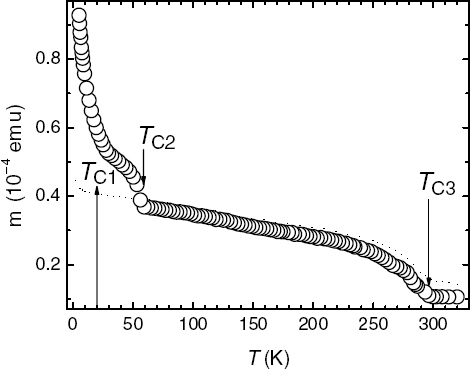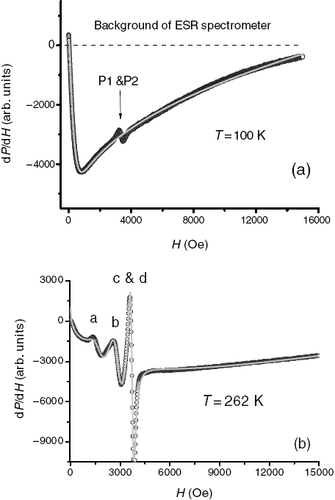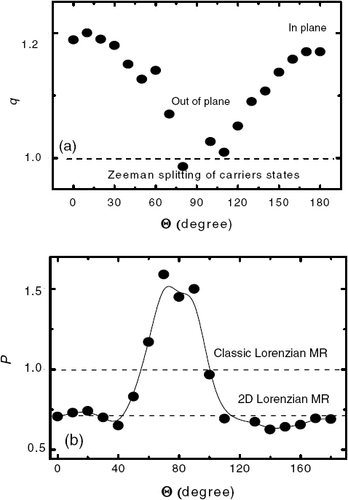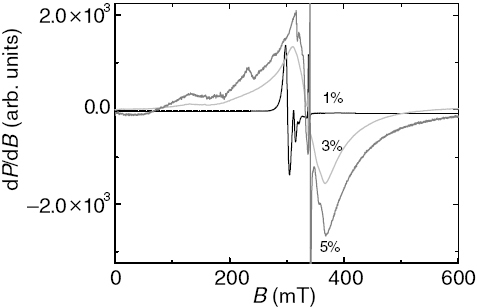Abstract
The Lorentzian and spin-scattering components of magnetoresistance were found and distinguished in Ge:Mn thin films. The suppression of microwave magnetoresistance by the limitation of the dimensionality of Ge nanowires doped with Mn has been revealed. Spin-wave resonance in the long-ordered magnetic state and ferromagnetic resonance in GeMn clusters have been detected.
Introduction
Both semiconductors and magnetic materials play an important role in modern electronics. Conventional electronic devices utilize the electron (hole) charge to process and store information. The use of an electron spin holds great promise for a new class of semiconductor memory and signal processing devices with new functionalities. The interplay of magnetism and semiconducting properties has been observed in magnetic semiconductors [Citation1, Citation2]. Generally, these types of materials have low Curie temperatures, which make them unsuitable for industrial applications. However, the unusual magnetic properties of nanostructures based on Ge and Si hosts doped with Mn have recently been demonstrated [Citation3–8]. Detailed investigations and the comparison of Ge1−xMnx bulk [Citation9] and 1D [Citation3–8] and 2D [Citation10–17] nanostructures have shown a noticeable difference in their static magnetic properties as well as the significant advantage of nanosized structures over the bulk state.
Both thin films [Citation18, Citation19] and nanoscale [Citation20] objects have previously been widely and successfully investigated by electron spin resonance (ESR) methods. Generally, an ESR spectrometer records changes in the microwave resonant absorption in the applied magnetic field, dP/dH. The microwave absorption depends not only on variations in the energy absorption due to ESR but also on changes in the sample resistivity in the magnetic field. In this work, we report an application of this technique for investigating both resonant and nonresonant microwave absorption in Mn-implanted Ge thin films.
Experimental
Ge:Mn thin films were prepared by implanting Mn+ ions into commercially available single-crystal Ge(100) wafers (initial\ resistivity=40–57 Ω cm). The Mn+ ions were implanted with an energy of 100 keV at fluences of 1×1016, 2×1016 and 4×1016 atoms cm−2. These fluences produce average volume concentrations of Mn of about 2, 4 and 8 at.%, respectively, on top of the Ge substrate. During the implantation, the samples were held at 300 °C to avoid amorphization. The maximum projected depth of Mn ions is about 120 nm for an implant designed to yield a quasi-Gaussian profile [Citation21]. The structural, electronic and static magnetic properties of these samples were extensively studied earlier by a number of experimental techniques [Citation21–24]. It was verified that samples with 4 and 8% Mn contain Mn5Ge3 crystalline clusters with mean diameters of 9.5 and 13.1 nm, respectively, embedded in a Ge matrix. The Ge matrix contains also diluted Mn ions at the substitution sites. In contrast, the sample with the lowest Mn concentration (2%) contains only Mn-rich amorphous clusters with a mean diameter below 7.5 nm. The amorphous (crystalline) clusters have a semiconducting (metallic) nature as discussed in [Citation23]. Nanowires were prepared in the pores of a dielectric membrane by the method of supercritical flow, described in [Citation3–5]. The magnetic resonance spectra were measured from the field dependences of the derivation of microwave absorption, dP/dH, using a Varian E-500 spectrometer equipped with an Oxford Instruments ESR-900 cryostat with the X- and K-bands at microwave field frequencies of 9.4 and 24.5 GHz, respectively, and a modulation frequency of 100 kHz in the temperature range T=4–300 K. Note that the microwave field penetrates into the sample only to the depth of the skin layer. In semiconductors with a dopant concentration level in the order of 1–10%, the skin layer has a depth of tens of microns in X- and K-band cavities, which far exceeds the thickness of the magnetically doped semiconductor film, t≅120 nm. Thus, all our results are applicable to all doped GeMn films.
Results
As the result of Mn implantation, the magnetic structure of the Ge:Mn film (x=4%) can be considered as consisting of two subsystems: (i) Ge3Mn5 nanoclusters with a mean size of 9.5 nm and at a distance of about 42 nm and (ii) individual Mn ions dispeced in a Ge matrix. These two systems have considerably different Curie temperatures: TC1 (dispersed Mn ions) ≈15 K and TC3(Mn5Ge3)=290–295 K (figure ). An additional transitional temperature, TC2=60 K, was found in the Mn-implanted Ge samples. TC2 is probably the Curie temperature of another type of clusters, for example, a fraction of amorphous GeMn precipitates, which become ferromagnetic below 60 K. The ESR spectra in Ge:Mn films exhibit a strong temperature dependence. Three main temperature intervals can be distinguished: low (T=4–60 K), intermediate (T=60–200 K) and high (T=200–300 K) temperatures.
Figure 1 Temperature dependences of magnetic moment measured during field cooling in a magnetic field of H=1 kOe, in the Ge:Mn film (x=4%). The dc magnetic field is normal to the film plane, θH=90°.

Complex magnetic resonance spectra containing a number of peaks are observed in Ge:Mn films with different Mn concentrations in the temperature range (T=4–60 K). The best experimental resolution is obtained for the sample containing 4% Mn. Its spectrum comprises three strong lines existing in a narrow temperature window, T=4–60 K. The magnetic susceptibility, χi(i=1–3), was estimated for each line using the relation χ=aIHpp2 (where I is the line amplitude, Hpp is the linewidth, a∼1 is the constant). The temperature and angular dependences of χi are similar for all lines. Comparison with the reference sample demonstrates that the values of χi exceed the magnetic susceptibilities of all Mn+ ions (N=2.6×1014 is the number of Mn+ ions dissolved in the Ge film when x=4%) by two orders of magnitude. This fact indicates that the observed resonances cannot be attributed to paramagnetic noninteracting Mn+ (or any other Mn2+, Mn3+, Mn4+) ions, because the multiplicity factor S(S+1) will not increase χ by a factor of 102. Thus, the resonant lines at these temperatures might be related to any collective resonant spin excitations (spin waves) in the whole film. Figure (a) shows the absorption spectrum dP/dH versus H at T=100 K. The spectrum differs significantly from those observed at low and high temperatures (figure (b)). It contains only weak resonant peaks P1 and P2 corresponding to some paramagnetic impurities observed in the Ge substrate, even without Mn implantation. Thus, these centers have no relation to the studied Mn-doped films.
Figure 2 X-band ESR spectra of the Ge:Mn film (x=4%) at (a) T=100 K and (b) T=262 K. The static magnetic field H is parallel to the film plane. The solid gray line is an approximation based on the magnetoresistance background (equation (1)), as described in the text.

A strong nonlinear background, exceeding the background of the spectrometer with an empty holder by a few orders of magnitude, dominates the spectrum. To clarify the nature of this background, we investigated the resonant spectra in X- (f≅9.5 GHz) and K-band (f≅24 GHz) resonant cavities. Although a strong shift of the resonant lines towards larger magnetic fields was observed, the background signal in our experiments remained frequency-independent (comparison is not shown). We found a strong angular dependence of the magnetoresistance (MR) signal, which indicated the contributions of a few different MR components, as discussed below.
As the temperature increases (T220 K) new resonant peaks a–d appear in the MR background in the field range H=1–4 kOe (figure (b)). Lines c and d are very close but can still be distinguished in the determined orientations. These lines fully covered small lines P1 and P2. The integral intensities of these peaks are larger than those of P1 and P2 and also that of the calibration sample by ∼2 orders of magnitude. The temperature dependences of the magnetic susceptibilities of these lines are nonmonotonic and have a maximum at T=260–270 K, close to the Curie temperature measured by the SQUID magnetometer. Thus, the high-temperature magnetic transition is accompanied by the appearance of resonant lines a–d. As the temperature further increases, these lines vanish at T310 K.
The orientation dependences of lines c and d at high temperatures change markedly with temperature. The angular dependences of lines c and d indicate fourfold symmetry and reveal the absence of the perpendicular magnetization component, which indicates that the magnetization vector M is oriented in the film plane in agreement with [Citation25]. In contrast, the angular dependence of resonant line b has a twofold character. Thus, the difference in angular dependences of the resonant lines at high temperatures does not allow us to associate these peaks with collective spin phenomena. It is probable that each resonant peak at high temperatures corresponds to a certain ferromagnetic cluster.
Regardless of the temperature region, none of the ESR spectra of the nanowires (1, 3 and 5%) contain any MR background and can be characterized by a few resonant lines (figure ). The narrow line with the g-factor of about 2.00 (H=3450 Oe) corresponds to the paramagnetic resonance of charge carriers (holes). Other lines correspond to 1D spin-wave resonance in long ordered ferromagnetic nanowires at low concentration (x=1%). At higher concentrations (x=3 and 5%) additional lines are admixtured to the spin-wave resonance and lead to spectra widening. According to the x-ray diffraction data, nanowires with Mn concentration exceeding 1% contain GeMn ferromagnetic alloy clusters. The additional lines probably correspond to the ferromagnetic resonance in these clusters.
Discussion
As the distance between the ferromagnetic Mn5Ge3 clusters is too large, no long-range magnetic ordering is possible in the high-temperature regime (T>220 K). Therefore, the observed resonances (lines a–d in figure (b)) can be attributed to spin excitations in various types of ferromagnetic GeMn clusters segregated in the Ge matrix as well as to dispersed Mn ions in their paramagnetic state. This assumption is also supported by the observed difference in the orientation dependences of resonant lines a–d. As the temperature decreases below TC1=10 K, both magnetic subsystems become ferromagnetic and long-range magnetic ordering generally becomes possible in the film. A low-temperature spectrum (not shown) may correspond to a collective excitation of spins in the ferromagnetic state of the sample. As previously shown [Citation26]–[Citation28], spin-wave resonances (SWRs) can be excited in a thin inhomogeneous ferromagnetic film by a uniform rf field assuming that spins are pinned at the boundaries of the sample due to surface anisotropy. Spin waves might be excited in thin inhomogeneous films measured in both perpendicular and parallel geometries [Citation27, Citation28].
To describe the MR, we took into account the fact that in low magnetic fields the derivation of the microwave absorption dP/dH is negative, whereas it is positive in high fields. The best approximation to this rapidly decreasing part of the MR signal can be achieved using the exponential function dP/dH=A(1−exp(BHq)), where A and B are field-independent coefficients. The derivative reaches a temperature-dependent minimum at H≅1–4 kOe then becomes positive (figure ). The high-field part of the MR was approximated by the function dP/dH=CHp, where C is a constant. The values of A and C depend on a number of factors, such as the sample geometry and size. On the other hand, exponents p≅1 and q≅1 reflect the physical nature of the MR and are, therefore, more interesting for consideration. We further focus our attention on the temperature and angular dependences of these coefficients. A good approximation of the experimental background (see figure ) was obtained by the sum
(1)
A similar expression was used for the approximation of the MR in other semiconductors [Citation29]. The angular dependences of p and q, p(θ) and q(θ), extracted during the approximation, are shown in figure . First, we discus the low-field part of the MR. When the sample rotates around an axis lying in its plane, q varies in the range 1.0–1.2. For θ=90° (the dc magnetic field is normal to the sample plane), q=1.0, which indicates that the MR occurs due to the Zeeman splitting of charge-carrier states near the tail of the localized states on a Fermi level band [Citation29, Citation30]. These localized states are degenerate in a zero magnetic field. The applied magnetic field causes the Zeeman splitting and shifting of states. As the result, the probability of hopping, the carrier mobility and the density of states change. In this model, B=−2–4×10−4 Gauss−1∼μ0μBgS(S+1)/kT (where k is the Boltzmann constant, μB is the Bohr magneton, T is the temperature), which is in good agreement with the value at room temperature (B=4×10−4 Gauss−1) obtained from the approximation (figure ).
Figure 4 Angular dependences of exponents q (a) and p (b) (equation (1)) at T=270 K, which describe the low- and high-field components of the magnetoresistance, respectively. The size of the symbols corresponds to the error bar. Horizontal lines show predictions corresponding to different magnetoresistance models.

However, when the external magnetic field is tilted away from the sample normal, the model based on the Zeeman effect is no longer valid. In particular, for θ=0° (the dc magnetic field is in the sample plane), q=1.2, which indicates a significant deviation from the simple model described above. This can be explained by the additional contribution of the anisotropic MR, which is superimposed on the hopping Zeeman MR, which is usually isotropic. The anisotropy of the low-field part of the MR obtained in our experiments may cause the limitation of wavefunctions in quasi-two-dimensional films, as found in [Citation31, Citation32].
The high-field part of the MR is quasi-linear, dP/dH∼CHp. The p varies in the range 0.75–1.60 (figure (b)). At θ=0° (the dc filed is in the film plane), p=0.75. At θ=90° (out-of plane orientation) p=1.5–1.6. These values of p are compatible with the Lorenzian MR, p=1, existing in most conductors and semiconductors as a result of the orbital motion of charge carriers in the magnetic field. The deviation of p from 1 is typical for conductive systems with limited dimensionality and a high dopant concentration [Citation33, Citation34]. In particular, a relatively low value of p=0.5–0.8 is expected in 2D disordered semiconductors with a high dopant level (which corresponds to our case).
It is important to note that field-dependent MR has never been observed in 1D DMS nanostructures of a similar chemical composition (Ge1−xMnx nanowires (x=1–5%), see figure ). Thus, this fact implies dimensional limitations on the effect of spin-dependent scattering in the Ge:Mn system and confirms the role of the dimensionality of the studied material.
Conclusions
The microwave absorption in Mn-implanted Ge thin films with dopant concentrations of 2, 4 and 8% has been investigated. At high temperatures (T=220–290 K), resonant peaks correspond to the ESR in ferromagnetic Mn5Ge3 clusters. On the other hand, low-temperature resonances (T=4–60 K) can be interpreted as arising from spin wave excitation. The appearance of spin wave resonances at low temperatures indicates the presence of long-range spin states and a cooperative magnetic response originating from spin ordering in the whole system.
We showed that the MR background contains two components: a positive classic Lorentzian part and negative part arising from the Zeeman splitting of charge carriers at the tail of the localized states on the Fermi level. The orientation dependence of both components is explained by a superposition of the isotropic part of the MR due to the Zeeman splitting of the charge carriers states and its anisotropic part caused by dimensional limitations of the thin film. The comparison of the MR in Ge:Mn thin films and nanowires (1, 3 and 5% Mn concentrations) indicated the suppression of MR by the dimensional limitations on the effect of spin-dependent scattering in the Ge:Mn system.
Acknowledgments
We are grateful to Professor M Farle for his comments, discussion and help in obtaining these results and to M Passacantando and L Ottaviano for the samples and detailed information on their structure and chemical composition. This work was partially funded by JSPS (05388) and the NMS project ESQ01T1 of DTI, UK.
References
- DietlT 2003 Nat. Mater. 2 646 http://dx.doi.org/10.1038/nmat989
- DietlT 2007 J. Phys.: Condens. Matter 19 165204 http://dx.doi.org/10.1088/0953-8984/19/16/165204
- KulkarniJ SKazakovaOErtsDMorrisMShawM THolmesJ D 2005 Chem. Mater. 17 3615 http://dx.doi.org/10.1021/cm050352a
- KazakovaOKulkarniJ SHolmesJ DDemokritovS O 2005 Phys. Rev. B 72 094415 http://dx.doi.org/10.1103/PhysRevB.72.094415
- KulkarniJ SKazakovaOHolmesJ D 2006 Appl. Phys. A 85 277 http://dx.doi.org/10.1007/s00339-006-3722-x
- JametM et al 2006 Nat. Mater. 5 653 http://dx.doi.org/10.1038/nmat1686
- WuH WTsaiC JChenL J 2007 Appl. Phys. Lett. 90 043121 http://dx.doi.org/10.1063/1.2432273
- KazakovaOKulkarniJ SArnoldD CHolmesJ D 2007 J. Appl. Phys. 101 09H108 http://dx.doi.org/10.1063/1.2694052
- ChoSChoiSHongCKimYKettersonJ BKimB-JKimY CJungJ-H 2002 Phys. Rev. B 66 033303 http://dx.doi.org/10.1103/PhysRevB.66.033303
- ParkY DWilsonAHanbickiA TMattsonJ EAmbroseTSpanosGJonkerB T 2001 Appl. Phys. Lett. 78 2739 http://dx.doi.org/10.1063/1.1369151
- ParkY DHanbickiA TErwinS CHellbergC SSullivanJ MMattsonJ EAmbroseT FWilsonASpanosGJonkerB T 2002 Science 295 651 http://dx.doi.org/10.1126/science.1066348
- TsuiFHeLMaLTkachukAChuY SNakajimaKChikyowT 2003 Phys. Rev. Lett. 91 177203 http://dx.doi.org/10.1103/PhysRevLett.91.177203
- PintoNMorresiLFiccadentiMMurriRD’OrazioFLucariFBoarinoLAmatoG 2005 Phys. Rev. B 72 165203 http://dx.doi.org/10.1103/PhysRevB.72.165203
- LiaA PShenJThompsonJ RWeiteringH H 2005 Appl. Phys. Lett. 86 152507 http://dx.doi.org/10.1063/1.1899768
- PanguluriR PZengChWeiteringH HSullivanJ MErwinS CNadgornyB 2005 Phys. Status Solidi B 242 R67 http://dx.doi.org/10.1002/pssb.200510030
- YuS SAnhT T LIhmY EKimDKimHHongS KOhSKimC SLeeH JWooB C 2006 Curr. Appl. Phys. 6 545 http://dx.doi.org/10.1016/j.cap.2005.11.057
- LiH LLinH TWuY HLiuTZhaoZ LHanG CChongT C 2006 J. Magn. Magn. Mater. 303 e318 http://dx.doi.org/10.1016/j.jmmm.2006.01.237
- FarleM 1998 Rep. Prog. Phys. 61 755 http://dx.doi.org/10.1088/0034-4885/61/7/001
- LiuXFurdynaJ K 2006 J. Phys.: Condens. Matter 18 R245 http://dx.doi.org/10.1088/0953-8984/18/13/R02
- SkomskiR 2003 J. Phys.: Condens. Matter 15 R841 http://dx.doi.org/10.1088/0953-8984/15/20/202
- OttavianoLPassacantandoMPicozziSContinenzaAGunnellaRVernaABihlmayerGImpellizzeriGPrioloF 2006 Appl. Phys. Lett. 88 061907 http://dx.doi.org/10.1063/1.2171485
- PassacantandoMOttavianoLLucariFde BiaseMImpellizzeriGPrioloF 2006 Phys. Rev. B 73 195207 http://dx.doi.org/10.1103/PhysRevB.73.195207
- OttavianoLParissePPassacantandoMPicozziSVernaAImpellizzeriGPrioloF 2006 Surf. Sci. 600 4723 http://dx.doi.org/10.1016/j.susc.2006.07.042
- OttavianoLPassacantandoMVernaAGunnellaRPrincipiEDi CiccoAImpellizzeriGPrioloF 2006 J. Appl. Phys. 100 063528 http://dx.doi.org/10.1063/1.2337388
- KittelC 1958 Phys. Rev. 110 1295 http://dx.doi.org/10.1103/PhysRev.110.1295
- SeaveyM HTannenwaldP E 1958 Phys. Rev. Lett. 1 168 http://dx.doi.org/10.1103/PhysRevLett.1.168
- SalanskijN MErukhimovM Sh 1975 Physical Properties and Applications of Magnetic Films Moscow Nauka
- HoekstraBStapeleR PRobertsonJ M 2000 J. Appl. Phys. 48 382 http://dx.doi.org/10.1063/1.323339
- KhoslaR PFisherJ R 1970 Phys. Rev. B 2 4084 http://dx.doi.org/10.1103/PhysRevB.2.4084
- KubelikITriskaA 1973 J. Phys. B: At. Mol. Phys. 23 115
- ButkoV YuDiTusaJ FAdamsP W 2000 Phys. Rev. Lett. 85 162 http://dx.doi.org/10.1103/PhysRevLett.85.162
- ShklovskiiB ISpivakB Z 1991 Hopping Transport in Solids MPollak BShklovskii Amsterdam Elsevier p 271
- ParishM MLittlewoodP B 2003 Nature 426 162 http://dx.doi.org/10.1038/nature02073
- RothHStraubW DBernardWMulhernJ E 1963 Phys. Rev. Lett. 11 328 http://dx.doi.org/10.1103/PhysRevLett.11.328
